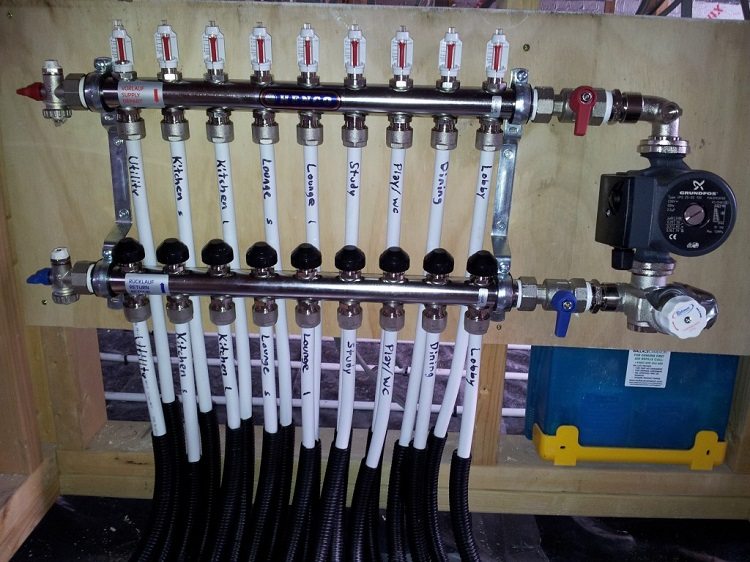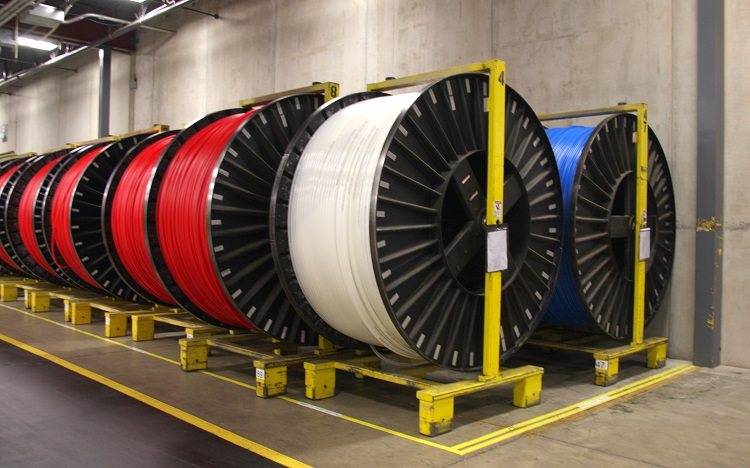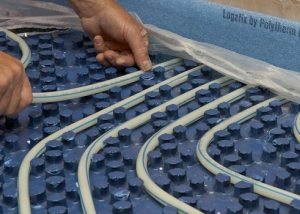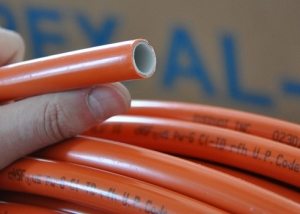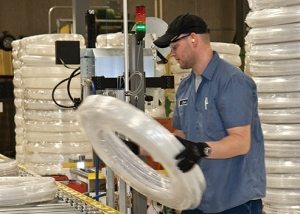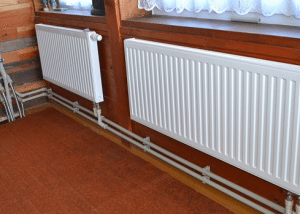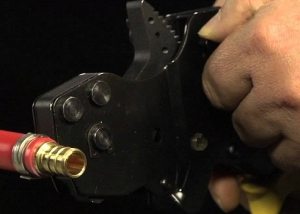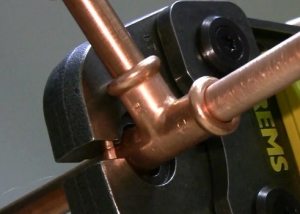Cross-linked polyethylene pipes represent a generation of polymer pipelines that are widely applicable in the installation of water supply systems (both hot and cold), as well as low-temperature heating networks, including the installation of a warm floor. Simplicity and reliability of operation, relatively low cost and good flexibility determine the popularity of such products.
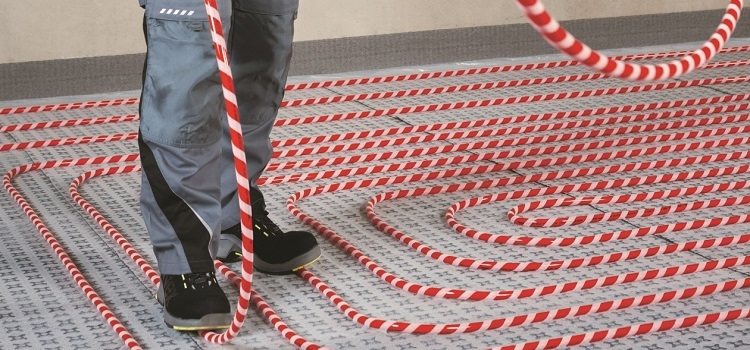
Cross-linked polyethylene is the most convenient and practical material for installing underfloor heating
Content
Underfloor heating system
The arrangement of the underfloor heating system allows to some extent save on the purchase of additional heating appliances. For its operation, a coolant temperature in the range from 33 to 55 ° C is required, which depends on the type of pipe used, the thickness of the screed and the purpose of the room.
A pipe is the main element of a warm water floor. The functionality and durability of the system depend on her choice. In addition, the system includes such parts and blocks:
- thermal insulation materials;
- fasteners for heating circuit products;
- waterproofing materials;
- distribution manifold;
- heat conducting materials.
Heating with a warm water floor occurs by transferring the thermal energy of the water to the surrounding space. Installation of such a heating system is carried out according to regulatory documents. The calculation of the length of the required pipes and the distances between them is based on information about the area of the room, the power of the water heating equipment, the type of insulation used, as well as the material of the floor and walls.
It is also necessary to ensure an even distribution of heat over the surface and to prevent the occurrence of too much heat in some places.
Cross-linked polyethylene: material features
Crosslinked polyethylene is produced physically or chemically. When it is created, the links of ethylene molecules through cross-links form a spatial (three-dimensional) grid with cells. Crosslinked polyethylene as a material is designated PE-X. By the method of production emit: RE-Xa, RE-Xb, RE-Xc, RE-Xd.
PE-Xa is a polymer that forms when heated with peroxides. PE-Xb polyethylene is obtained by moisture treatment with a catalytic substance and implanted silane. PE-Xc is a material formed after electron bombardment of polymer molecules. PE-Xd is extremely rare and is produced using nitrogen technology.
Note! Since the strength characteristics of crosslinked polyethylene are laid at the level of molecules, breaking bonds is very difficult.
Pipes made of PE-X crosslinked polyethylene are best suited for underfloor heating.
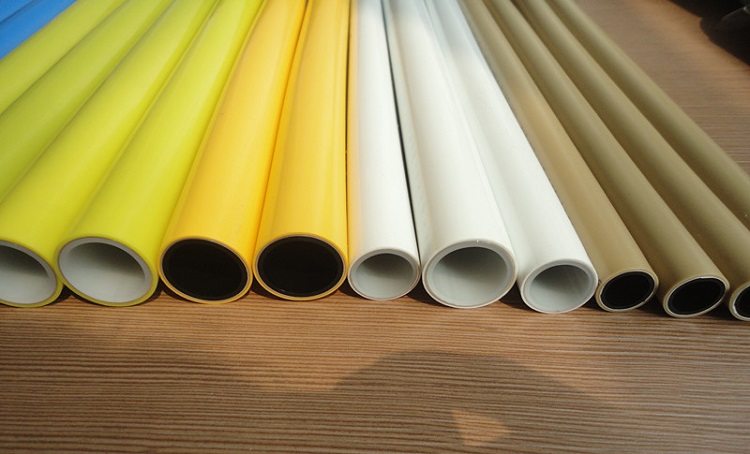
There are several types of pipes made of cross-linked polyethylene, they differ in the manufacturing method.
Pipe options for underfloor heating
There are a number of requirements for products from which the installation of a warm floor is carried out. Such pipes must be resistant to mechanical stress and have a long service life.Environmental safety, corrosion resistance and low linear expansion coefficient of products are also important.
The pipe for the warm floor should have high heat transfer, elasticity and the ability to absorb noise.
Not only cross-linked polyethylene products, but also copper, metal-plastic, polypropylene and corrugated steel pipes correspond to such characteristics to varying degrees. Communications made of copper for a warm floor, along with its advantages, are of high cost. In addition, during installation, additional elements will be required: polymer shells and brass fittings.
Although the consumption of corrugated steel pipes for underfloor heating is somewhat lower than that of copper, the price solutions are almost identical. Polypropylene pipes have an affordable price, low weight and are easy to install, but their linear expansion during heating is significant. For laying in a concrete screed, they need to be reinforced with aluminum or fiberglass.
Metal-plastic transport lines have proven themselves in the construction of a warm floor. Among the disadvantages, it is possible to distinguish scale deposits, which eventually form inside threaded fittings.
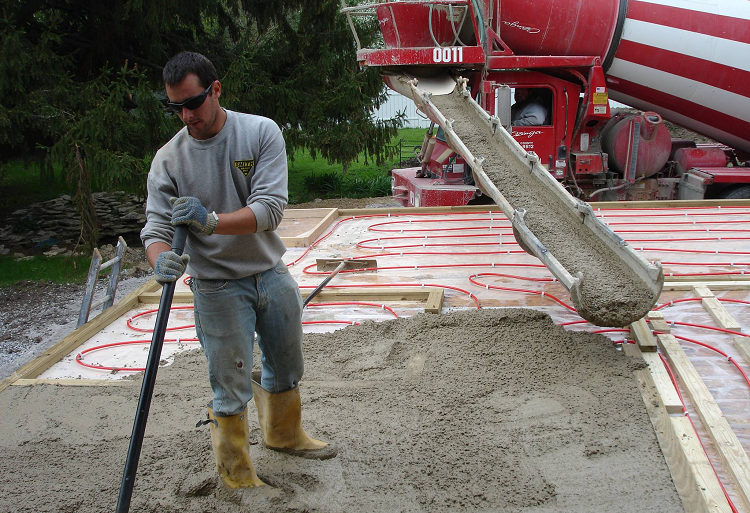
The pipes for the warm floor are laid under the screed, so you need to choose the most durable products
Positive properties of cross-linked polyethylene
A pipe made of cross-linked polyethylene has unique characteristics for a warm floor, among which they distinguish high heat resistance, reverse shrinkage, good elasticity and others. Products can withstand high heating temperatures (up to +120 ° C). Pipes from other polymers are able to maintain their properties only up to a temperature of +80 ° C.
Note! Crosslinked polyethylene has the property of self-healing after exposure to high loads.
Materials of similar composition under these conditions simply stretch and lead to contour ruptures.
When laying the contour of a warm floor, pipes made of cross-linked polyethylene can be bent over a relatively large radius, without fear of breaking them. They also have increased uptime. Polyethylene for the floor does not emit harmful substances, does not rot and is not susceptible to corrosion.
Being used for a warm floor, this material absorbs vibrations of the heat carrier well, which significantly reduces the noise level in the room.
Of the possible disadvantages, oxygen permeability is distinguished, which can cause exacerbation of corrosion in nearby materials. To reduce this effect, special spraying is used. When laying pipes made of cross-linked polyethylene, it is better to fix them immediately, since they do not hold firmly enough. To do this, use snap brackets or rails equipped with installation grooves.

Before laying pipes on the floor, you need to stock up on the fixtures for them, since you need to fix the laid sections immediately
Product Range Overview
The production of cross-linked polyethylene products is regulated by European standards. Regulatory documents that determine the assortment of pipes RE-X, allocate 19 sizes. The maximum throughput diameter is 25 cm and the wall thickness is 2.8 cm.
For the device of a warm floor, pipes having a diameter of 12-32 mm are used. This is due to the difficulty of pouring the screed with a larger thickness of the product. For most cases of installation of a warm floor, a 16 mm pipe is used, which provides maximum heat transfer, and also does not really affect the thickness of the screed.
When choosing communications from cross-linked polyethylene, it is important to consider the degree of crosslinking of the material. The requirements of the standards are set at no less than 65% (range 65-80%). This parameter affects the technical characteristics, service life and cost of products.
The leader in the market of communications used for warm are Rehau pipes.They are represented by a wide range of sizes and models, including universal specialized products Stabil, Flex, His, Pink. The pipeline is designed for a long service life at high temperature conditions. Uponor and Wirsbo are also popular models of cross-linked polyethylene.
Installation of underfloor heating system
Pipe laying can be done spirally, with a snake or with a double snake. Laying with a snake is simpler, but the heating will be uneven. The distance between the products should not exceed 35 cm. The average length of one circuit is 40-60 meters, but not more than 120. Otherwise, heat losses will be significantly increased, and the coolant on return will have a very low temperature.
A heat-insulating layer is laid under the pipe. It can be polystyrene foam boards, polystyrene foam, a reflector based on foamed polyethylene and others. Fastening is done with brackets, clips, single or double driven dowels. Some polystyrene plates are available with a coated profile for fixing pipes and marking.
Note! When pouring concrete, it is necessary to foresee the presence of expansion joints in the screed to cover the linear expansion of the products.
You can start the floor after the screed has completely hardened. The temperature of the coolant before entering the operating mode must be gradually increased - by 3-5 degrees per day.
If an external anti-diffusion protection is applied to cross-linked polyethylene, then installation is carried out only after checking the top layer of the product for damage.
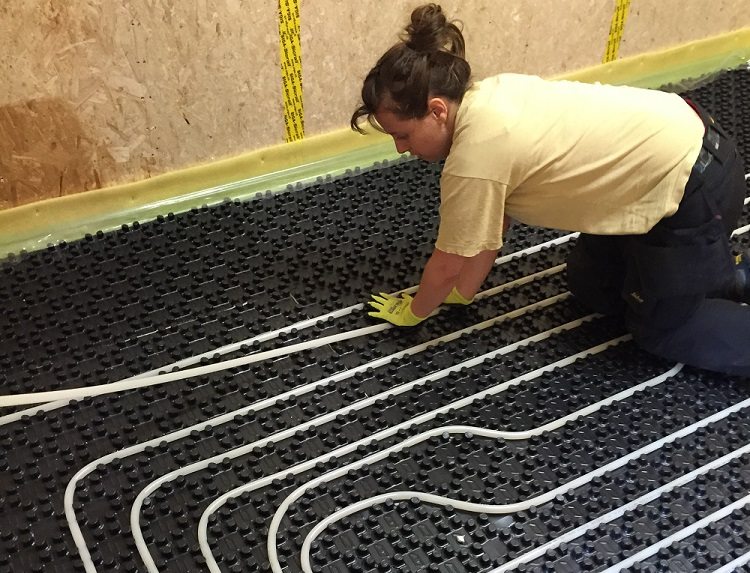
Pipe laying can be done according to different schemes, but the distance between the system segments should not exceed 35 cm
Crosslinked Polyethylene Products
If cross-linked polyethylene is selected for installation, pipes for underfloor heating can be connected by pressing and compression fittings. It’s easier to work with the second option.
A compression nut is put on the pipe to install the compression fitting. In this case, the thread should be directed towards the location of the connector. A cut ring is placed on the communication. Its edge should deviate from the pipe cut by about 1 millimeter.
Next, the fitting is pushed onto the product all the way, and the crimping nut is tightened with wrenches. When using fittings of this type, chamfering is not required. Also, do not apply excessive force when tightening the nut, as otherwise the pipe may be damaged.
Press fitting fittings form one-piece joints of products made of cross-linked polyethylene for underfloor heating. The implementation of such a docking option requires special equipment. To begin with, a clamping sleeve is put on. Then, an expander having an appropriate size is inserted into the pipe until it stops.
Its handles are smoothly reduced and fixed in this position for a while. At the next stage, the fitting is inserted and a sleeve is pressed onto it using a hydraulic or manual device.
The underfloor heating system is by far the most acceptable and optimal option for heating the room. The use of cross-linked polyethylene products can make it the most durable and efficient.
